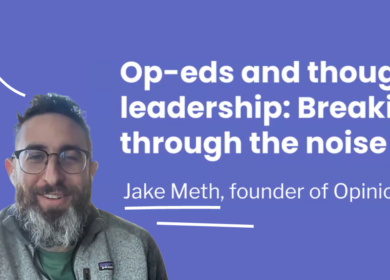
By Kelly Stone
The Hoffman Agency, Portland-Vancouver
Throughout my career in tech PR, I have seen a number of public relations professionals do incredible work with media, resulting in stories that both the author and the client celebrate. Many PR professionals build genuine relationships with reporters; the dynamic is thoughtful, genuine and supportive.
That said, let’s face it: many reporters do not enjoy engaging with PR professionals. To most reporters, emails from PR professionals are considered SPAM. Truly. We are, in fact, considered SPAM to people we dream about building relationships with.
Reporters have not shied away from sharing their less than favorable opinions on the myriad of pitches they receive, as they find that many of the pitches are not compelling or relevant to their beat. In reality, we know that these writers simply cannot sift through the hundreds of pitches they receive each day.
Here’s where I’ll admit that, in the past, I’ve done copy/paste pitching. When tasked with pitching 30 reporters at 5 a.m. when an embargo lifts, I’ve been guilty of less thoughtful outreach. To personalize a pitch, sometimes it requires only 15-30 minutes to research and re-write the email, but depending on how many reporters we’re tasked with outreaching to, this can take upwards of 10 hours.
On the other hand, if we asked reporters to spend just two minutes on each of the 250 pitches they receive per day, it would take them more than a full workday as well.
If both reporters and PR pros did this, we would be out of jobs. So, what is the solution?
My recommendation is to practice “Slow PR.” I have sent enough failed pitches and had enough frustrated phone conversations with reporters to know that Slow PR is the solution.
As Polina Opelbaum outlines in the PR Newswire piece, entitled: The “Slow PR” Trend: Building Traction Over Time Slow PR is “about building relationships, mutual respect, trust and credibility with reporters and through the product of that, the larger audience.” Slow PR is about truly knowing these journalists and uncovering both their professional and personal passions. It’s also about better understanding the publication they write for.
I know, I know… Earlier I pointed out that there’s often no time for this. So, rather than delving into how to practice Slow PR (we’re smart, we know what to do), I wanted to share a handful of tips on how to make Slow PR more feasible at an agency or on an account team:
- Request media lists sooner and ask for more details. Whenever possible (and I realize sometimes it’s not), request that media lists for announcements/outreach be finalized a few days in advance of the news, so the team can review their assigned media and conduct research before the news goes live.
As part of this, ask that the teammate pulling the media list together provide more detailed notes on why each reporter is recommended. Here’s an example: Sarah has written on wearable devices for the past three years. Her favorite devices are X, Y, Z due to their ability to do C, making her a good fit for this wearable news. Also, Sarah recently tweeted that she’s currently testing a new set of wearables, indicating that she’s open to trying new options.
- If a reporter doesn’t feel like a good fit, speak up. If you are tasked with conducting outreach to a reporter that you do not believe is a good fit, reach out to your team and share your concerns. Outline the research that resulted in this opinion. Also, if possible, recommend an alternative reporter that you believe is a better fit, so you are bringing forth a solution. At Hoffman, we welcome this type of feedback and always appreciate a well-researched media recommendation.
- Aim to own the same reporters across accounts. In order to build long-standing relationships with reporters, save research time, and provide sound recommendations regarding whether to pitch them, it’s important to own the outreach to the same reporters across accounts. If possible, take it a step further and see if you can own certain reporters for the entire agency, managing the pitch recommendations for accounts you do not work on. I realize that this can pose team structure and account billing challenges, so it’s not always possible, but it’s worth asking and seeing where you can streamline.
- Be realistic about media results when establishing goals and metrics. When clients get excited about upcoming news, I tend to get equally jazzed. Sometimes this excitement can impact the goals and metrics we establish for an announcement. If we excitedly and with good intentions aim too high, it can put more pressure on landing coverage. As a result, we are inclined to send as many pitches as possible. Let’s continue to take a step back and ensure we are setting realistic expectations.
- Pick up the phone. One of the most challenging things about practicing slow PR is spending upwards of four hours on a few pitches day after day and having nothing to show for it. No responses, no feedback. This is one reason why broadly pitching a multitude of reporters can have appeal, because you are more likely to have feedback for your team and your clients. Even if that feedback is “I’ll pass, too slammed,” it’s helpful.
With that in mind, I do recommend calling the reporters you’ve pitched to gauge their interest in the news (don’t kill me for saying this, reporters!). Often you will learn that they never opened your email. Other times, they will share thoughts they didn’t have time to outline in email. Some will also tell you to buzz off. However, having a conversation with a reporter can go a long way in benefiting the both of you.
As I continue to practice Slow PR, I know I won’t always hit the mark. I will get eager, or I will be in a time crunch or I will truly believe that I can “sell” someone on a piece of news, even if it’s not a perfect fit.
That said, I will continue to try, and I am thankful to be at an agency that supports the practice of Slow PR. Perhaps, just one email (or non-email) at a time, reporters may see us more and more as friends, not SPAM.

